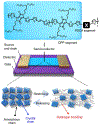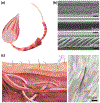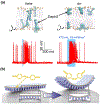Recent advances in bioelectronics chemistry
- PMID: 32672777
- PMCID: PMC7674226
- DOI: 10.1039/d0cs00333f
Recent advances in bioelectronics chemistry
Abstract
Research in bioelectronics is highly interdisciplinary, with many new developments being based on techniques from across the physical and life sciences. Advances in our understanding of the fundamental chemistry underlying the materials used in bioelectronic applications have been a crucial component of many recent discoveries. In this review, we highlight ways in which a chemistry-oriented perspective may facilitate novel and deep insights into both the fundamental scientific understanding and the design of materials, which can in turn tune the functionality and biocompatibility of bioelectronic devices. We provide an in-depth examination of several developments in the field, organized by the chemical properties of the materials. We conclude by surveying how some of the latest major topics of chemical research may be further integrated with bioelectronics.
Conflict of interest statement
Figures





























Similar articles
-
Recent Progress in Materials Chemistry to Advance Flexible Bioelectronics in Medicine.Adv Mater. 2022 Mar;34(10):e2106787. doi: 10.1002/adma.202106787. Epub 2022 Jan 27. Adv Mater. 2022. PMID: 34751987 Free PMC article. Review.
-
Wearable Bioelectronics: Enzyme-Based Body-Worn Electronic Devices.Acc Chem Res. 2018 Nov 20;51(11):2820-2828. doi: 10.1021/acs.accounts.8b00451. Epub 2018 Nov 6. Acc Chem Res. 2018. PMID: 30398344 Free PMC article.
-
From lab to wearables: Innovations in multifunctional hydrogel chemistry for next-generation bioelectronic devices.Biomaterials. 2024 Oct;310:122632. doi: 10.1016/j.biomaterials.2024.122632. Epub 2024 May 28. Biomaterials. 2024. PMID: 38824848 Review.
-
Wearable and Implantable Soft Bioelectronics Using Two-Dimensional Materials.Acc Chem Res. 2019 Jan 15;52(1):73-81. doi: 10.1021/acs.accounts.8b00491. Epub 2018 Dec 26. Acc Chem Res. 2019. PMID: 30586292 Review.
-
Electrochemical and Electrical Biosensors for Wearable and Implantable Electronics Based on Conducting Polymers and Carbon-Based Materials.Chem Rev. 2024 Feb 14;124(3):722-767. doi: 10.1021/acs.chemrev.3c00392. Epub 2023 Dec 29. Chem Rev. 2024. PMID: 38157565 Review.
Cited by
-
Recent Progress in Materials Chemistry to Advance Flexible Bioelectronics in Medicine.Adv Mater. 2022 Mar;34(10):e2106787. doi: 10.1002/adma.202106787. Epub 2022 Jan 27. Adv Mater. 2022. PMID: 34751987 Free PMC article. Review.
-
Nanoenabled Bioelectrical Modulation.Acc Mater Res. 2021 Oct 22;2(10):895-906. doi: 10.1021/accountsmr.1c00132. Epub 2021 Aug 30. Acc Mater Res. 2021. PMID: 34723193 Free PMC article.
-
Wearable bioelectronics based on emerging nanomaterials for telehealth applications.Device. 2025 Jan 17;3(1):100676. doi: 10.1016/j.device.2024.100676. Epub 2025 Jan 9. Device. 2025. PMID: 40206603 Free PMC article.
-
Label-free MXene-assisted field effect transistor for the determination of IL-6 in patients with kidney transplantation infection.Mikrochim Acta. 2023 Jul 7;190(8):284. doi: 10.1007/s00604-023-05814-y. Mikrochim Acta. 2023. PMID: 37417992
-
Towards Novel Geneless Approaches for Therapeutic Angiogenesis.Front Physiol. 2021 Jan 20;11:616189. doi: 10.3389/fphys.2020.616189. eCollection 2020. Front Physiol. 2021. PMID: 33551844 Free PMC article.
References
-
- Chortos A, Liu J and Bao Z, Nature Materials, 2016, 15, 937–950. - PubMed
Publication types
MeSH terms
Grants and funding
LinkOut - more resources
Full Text Sources

